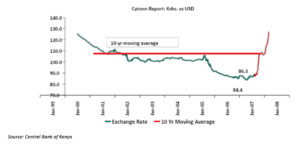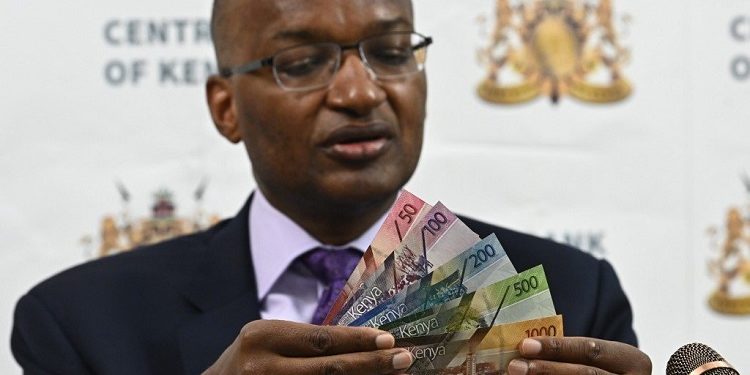Over the last 10 years, the Kenyan shilling has depreciated at a 10-year CAGR of 3.7% to an all-time low of Kshs 125.6 in February 2023 from Kshs 87.3 over the same period in 2013, mainly attributable to various factors such as an ever-present current account deficit, increasing debt levels and the rising prices of commodities such as crude oil prices as Kenya remains a net importer.
In 2023, on a YTD basis, the shilling has depreciated by 1.8% against the USD, to close at Kshs 125.6, from Kshs 123.4 recorded on 3rd January 2023.
The continued depreciation in 2023 is mainly attributable to sustained dollar demand by importers, especially in the oil and energy sector against a low supply of dollar currency leading to a shortage of US Dollars in the Kenyan market. The chart below illustrates the performance of the Kenyan Shilling against the US Dollar over the last 10 years:

Below are some of the factors that have been putting the Kenyan shilling under significant pressure;
- High global crude oil prices are attributable to persistent supply chain constraints and high demand with fuel being an integral input in most sectors of the economy. Consequently, this increased dollar demand by oil and energy importers, as well as, manufacturers against a low supply of dollar currency. The high dollar demand has caused a shortage of US Dollars in the Kenyan market further inflating the country’s import bill and consequently weakening the shilling,
- Existence of an ever-present current account deficit estimate at 4.9% of GDP in 2022, despite improving by 0.3% points from 5.2% recorded in 2021. The ever-present current account deficit signifies the country’s reliance on imports and with the high global commodity prices, it has resulted in increased demand for foreign currency which weighs down on the local currency,
- A deterioration in Kenya’s trade imbalance as a result of adverse macroeconomic conditions in the country. According to the Kenya National Bureau of Statistics Q3’2022 Balance of Payments Report, Kenya’s balance of payments deteriorated by 283.9% in Q3’2022, coming in at a deficit of Kshs 112.7 bn, from a deficit of Kshs 29.3 bn in Q3’2021. The deterioration was brought by a 5.5% widening of the Current Account deficit to Kshs 193.4 bn, from Kshs 183.4 bn in Q3’2021, driven by a 15.8% deterioration in trade imbalance to Kshs 373.1 bn, from Kshs 322.0 bn in Q3’2021. Consequently, with Kenya being a net importer, the shilling has continued to weaken as a result of increasing import bills mainly attributable to the high global commodity prices,
- High debt levels and increasing debt servicing costs with Kenya’s public debt has grown exponentially at a 10-year CAGR of 17.7% to Kshs 9.1 tn in December 2022, from Kshs 1.8 tn in December 2012, with external debt contributing 51.1% of the total debt. Consequently, the increasing debt servicing costs mainly on the back of the continued weakening of the shilling have put pressure on forex reserves given that 69.3% of Kenya’s External Debt was US dollar-denominated as of October 2022. Additionally, the projected amounts that are expected to be used for foreign debt servicing in FY’2023/2024 stands at Kshs 475.6 bn, which is likely to put more pressure on forex reserves as most of it will be used to repay the debts, and,
- High debt servicing costs are mainly a result of the continued appreciation of the dollar and aggressive depreciation of the shilling on the back of the monetary policy tightening by the United States Federal Reserve. Consequently, this has resulted in continued dwindling of the country’s forex reserves given that 69.3% of Kenya’s External Debt was US dollar-denominated as of October 2022.
However, the following factors have supported the shilling from further depreciation;
- Strong diaspora remittances, which have grown by a 10-year CAGR of 13.0% to USD 349.4 mn in January 2023, from USD 103.0 mn recorded in January 2023, attributable to the increasing Kenyan population in the diaspora and advancing technology that has facilitated the easier transfer of money. The chart below shows the trend of the evolution of Diaspora Remittances:
- The sufficient forex reserves held by the Central bank have been above the statutory target of 4.0 months import cover in the last 10 years, with an average of USD 7.3 bn and 5.1 months average import cover.
- The value of the country’s principal exports has continued to grow over time consequently increasing foreign inflows which support the local currency. Notably, in Q3’2022, the value of horticulture and tea exports contributed Kshs 40.3 mn and Kshs 34.5 mn, respectively out of the total value of exports of Kshs 200.5 mn. The current account deficit as a percentage of the Gross Domestic Product (GDP), has also continued to narrow with the deficit estimated to have narrowed to a deficit of 4.9% by the end of 2022, from a deficit of 5.2% in FY’2021,
- Before the onset of the Coronavirus pandemic, the country attracted huge foreign investment as evidenced by the Foreign Direct Investments (FDI) flows into the country, which had grown significantly by an 8-year CAGR of 16.0% to USD 1.1 bn in 2019, from USD 0.3 bn in 2011. However, after economic disruptions caused by the COVID-19 pandemic which resulted in reduced investor activities, FDI flows into the country have declined in two consecutive years to USD 0.7 bn and USD 0.4 bn in 2020 and 2021, respectively,
- Kenya has continued to receive financing from the World Bank and other bilateral lenders such as the International Monetary Fund (IMF) which have supported the Kenyan shilling by boosting the forex reserves. Notably, the funding amounting to USD 1,433.0 mn disbursements to the government from both the World Bank and the International Monetary Fund (IMF) in 2022 supported the reserves, and,
- Tightened monetary policy with the Monetary Policy Committee (MPC) continually hiking the central Bank rate by a cumulative 1.75% points to 8.75% from the previous 7.00% in a bid to anchor inflation which has surpassed the government’s target range of 2.5%-7.5% and also strengthen the Kenyan shilling from further aggressive depreciation.
Going forward, we expect the Kenya Shilling to trade within the range of between Kshs 130.2 and Kshs 134.4 against the USD in 2023 based on the purchasing power parity (PPP) and interest rate parity (IRP) approach respectively, with a bias of a 6.4% depreciation mainly driven by:
- The ever-present current account deficit with Kenya being a net importer, which will increase dollar demand in the market, and,
- The currently high global crude oil prices that have weighed in on the dollar demand from oil and energy importers who will have to increase the amounts they pay for oil imports and hence depleting the dollar supply in the market.
Despite the fact that the current pressure on the Kenyan shilling is unlikely to abate in the near term, there are actionable steps that can be taken by the Government to mitigate further depreciation of the shilling. These include;
- Formulate policies to enhance a more diversified economy- There is a need to enact policies to promote diversification of the economy with a key focus on improving Kenya’s manufacturing sector in order to create an economy that is less dependent on agriculture. Key to note, the manufacturing sector contributes less than 10.0% to the country’s GDP, despite the fact that it could contribute more given the various opportunities available. This will consequently improve the country’s current account deficit through increased exports as well as preserve the country’s foreign exchange reserves, which will go a long way in stabilizing the exchange rate,
- Enhancing fiscal consolidation– This will address the high fiscal deficit arising from the higher government expenditure as compared to the revenue collections which have continued to be the main driver of the high borrowing levels. The government can bridge the deficit gap by instituting austerity measures, reducing amounts extended to recurrent expenditure, and focusing on developments that will give back to the economy. These will reduce the government’s need for aggressive borrowing and in turn stabilize the exchange rate,
- Reduction of commercial loans. There is need for the government to reduce the share of commercial loans in order to reduce debt servicing costs. This is mainly because commercial loans attract higher interest rates as compared to concessional borrowings. Reduced debt service amounts would greatly help to bring down demand for the dollar and stabilize the exchange rate,
- Building an export-driven economy. The government can do this by formulating and implementing robust export-oriented policies and manufacturing to increase exports aimed at reducing the current account while reducing overreliance on imports to preserve the country’s foreign exchange reserves,
- Alternative projects financing strategies. The government should diversify the sourcing of funding for infrastructure projects in the country to further shift to alternative financing strategies such as Public-Private Partnerships (PPPs) and joint ventures. This will attract more private sector involvement in funding development projects such as infrastructure instead of borrowing, and,
- Formulation of investment-friendly policies. The Government should work in close conjunction with banks to allow for favorable accounts for diaspora citizens, which will encourage them to remit more money back to the country hence cushioning the shilling against further depreciation. This can be done by reducing money transfer costs by exploring alternative channels for remitting money by leveraging on digitization and technology and explore alternative channels.
The interest rates environment in Kenya has witnessed high volatility as evidenced by the significant increase in yields on the government papers.
The continued rise in the yields in government papers is a result of investors attaching a higher risk premium to the country, driven by the elevated inflationary pressures, high public debt, and currency depreciation that have put the country’s macroeconomic environment at risk.
Going forward, we expect a continued upward readjustment on the yield curve with our sentiments being on the back of:
- Increased pressure on the government to meet its budget deficit by borrowing more domestically. The government is likely to accept expensive bids and in turn destabilize the interest rate environment, and,
- Uncertainties about the economy occasioned by elevated inflationary pressures have resulted in high credit risk which hampers lending to businesses and individuals.
We believe that in order for the government to ease pressure on the interest rate, they should:
- Shift financing strategies to prioritize concessional financing, and use commercial borrowing in limited amounts. This will ease pressure given the current depreciation of the shilling and also given that the concessional funding has low-interest rates and longer repayment periods,
- Focus on borrowing domestically in the short and medium term, given that domestic debt provides the government with a cheaper source of debt compared to foreign currency-denominated debts that have higher interest rates and have currency risks attached to them,
- Continue implementation of measures to reduce debt service to revenue ratio which was estimated at 51.1% as of December 2022, 21.1% points higher than the recommended threshold of 30.0%, and 1.1% points higher than FY2020/2021’s debt service ratio of 50.0%, attributable to increased debt service obligations mainly on the back of the depreciated local currency, and,
- Diversification of funding of projects by removing bottlenecks to Private Public Partnerships (PPPs) and joint ventures in order to attract more private sector involvement in funding development projects such as infrastructure instead of borrowing.
For more information, click the link below Currency and Interest Rates Outlook
Email your news TIPS to editor@thesharpdaily.com

















